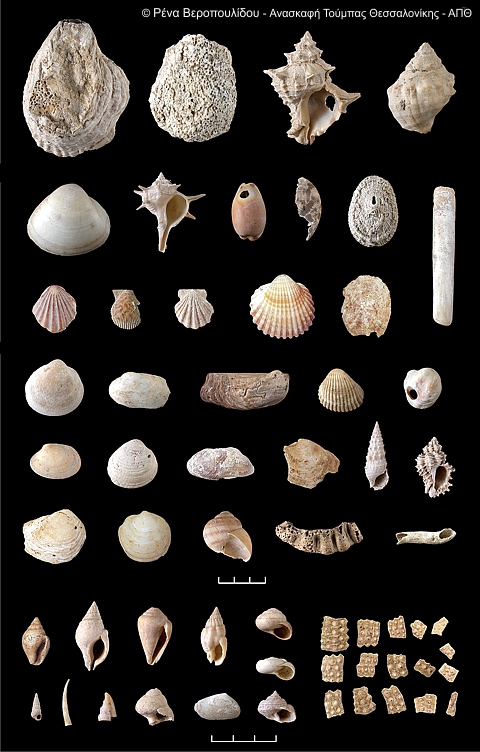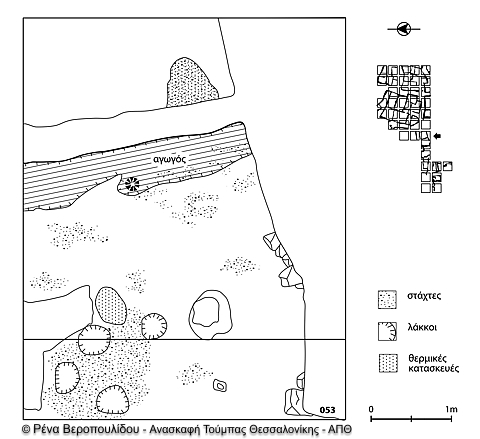Archaeomalacological Material
The archaeomalacological material of Toumba comprises the largest known assemblage among Bronze Age settlements in Greece. The systematic recovery of the shells during the excavation, as well as the plethora of information that emerged from the study of other categories of findings, provided the opportunity for a detailed examination of the material on both a synchronic and a diachronic level.
The objective of the study was to estimate the lifecycle and the consumption context of the shells from the end of the Early Bronze Age to the Early Iron Age.
The archaeomalacological material displays a wide range of molluscan species, which befits the position of the settlement, as it is close to a rich aquatic environment. According to the data, the inhabitants used to gather shells from sources in proximity to their residential and production area on a systematic basis throughout the settlement's lifecycle, while, during the last occupation phases, this practice became particularly intensive. This means that the collection activity constituted a discrete field within the production structures of the farming community, as it provided it with food and important raw materials for the manufacture of various products, such as purple dye and jewelry.
The inhabitants used to consume a wide variety of molluscan species, but they appeared to have a special preference for lagoon cockles (Cerastoderma glaucum), a species they gathered from the streams' estuaries.These had already been the main type of food, as far as molluscs across the region of Central Macedonia are concerned, since the Early Neolithic Period (6500 BC), thus, serving as a particular characteristic of the choices in food consumption practices in the area. Lagoon cockles, as well as other species, were consumed boiled, roasted and raw; cooking method perhaps depending on the menu and the food consumption context. The consumption of mollusks became more intensive and more varied during the latest phases of the Late Bronze Age and the Early Iron Age. This fact, together with the increase in animal meat consumption, indicates that the community of Toumba used to amass large amounts of food, probably consumed in the context of festive occasions..
The production of purple dye was another aspect of mollusks consumption in the settlement was . Despite the fact that neither raw materials themselves nor any dyed Another aspect of use of molluscs at the site was related to the production of purple dye. Painted products have not been recovered in the settlement, the production of purple dye was confirmed by the vast amount of crushed purple shells (Hexaplex trunculus).The Toumba settlement inhabitants produced dyes in light blue, blue and purple hues, which were to be used in the dyeing of yarns and fabrics. In parallel with that, it is highly likely that they were also employed for decorating either structural elements or the human body. It is also probable that the inhabitants followed specific “recipes,” depending on how and where the dye was to be applied or even depending on the shades they preferred..
Evidence of purple dye production can be traced back to the earlier occupation phases of the settlement and, specifically, to workshop areas dated in the end of the Middle Bronze Age and demonstrate the dye production in situ. Purple shell production was a practice, which continued uninterrupted and, almost, with unabated intensity until the Early Iron Age. Despite the fact that no corresponding workshop areas were detected in earlier occupation phases, the discovery of shattered shells in each area indicates that the first, at least, stages of the process took place within a domestic context. Therefore, purple dye production was a small-scale house industry throughout the settlement’s lifecycle. It is highly likely that it aimed to meet the needs of each residential group and, generally, the needs of the community, much like other “luxurious” goods in the settlement, such as the Mycenaean style pottery and metal objects.
Lastly, shell artifacts were manufactured in the settlement, mainly personal objects for decorative purposes and, less frequently, some abrasion and cutting tools. The most common type were the Cerastoderma glaucum perforated shells that is, the remains of the main food type, but also other types of shell species, such as dentalia, cones and cowries, either individually (pendants) or in compositions (necklaces).
Consequently, molluscs and shells were used by all inhabitants throughout the lifecycle of the settlement, as part of their diet and for various house activities with the purpose of meeting the needs of the community as well as promoting its social and political reproduction.
Dr Rena Veropoulidou
Ministry of Culture, Education and Religious Affairs



